roasted delicata squash stuffed with moroccan quinoa
+ my handy dandy guide to all things *winter squash*
Tomorrow is the first official day of fall (!) and it’s going to be a properly cold, rainy, and cozy day around here… not gonna lie, I’m pretty excited to hunker down in my flannel pajamas, drink coffee from my favorite Waffle House mug, eat some overly-sweet doughnuts, and embrace all the autumnal vibes.
In the spirit of the changing seasons, today I’m sharing a quick cheat sheet on all things winter squash… not sure how to pick the best squash? How to store it? Or what’s the difference between all the varieties? I’ve got you covered!
Winter Squash Selection & Storage
When purchasing winter squash, look for firm outer skin with no soft spots. Stems on ripe winter squash should be dark green or brown, dry, and very firm.
Store your winter squash in a cool, dry spot like a pantry (not in the fridge). Note that shelf life varies depending on the variety, but acorn, delicata, and spaghetti squash tend to be the most perishable, and are best enjoyed within 4 weeks.
Common Varieties of Winter Squash
*Note that there are a LOT more varieties of winter squash out there, but this is a list of some of the most common ones.
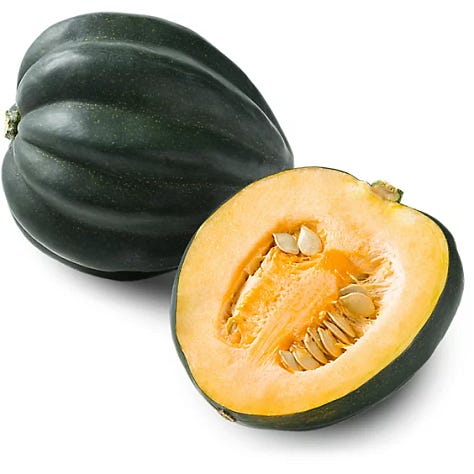

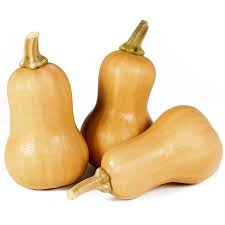
Acorn - named for it’s acorn-like shape, this variety of winter squash has dark green outer skin and bright orange flesh. The flavor is nutty and has a mild sweetness, and the texture can be a bit fibrous. Their smaller size makes them a great option for personal-sized portions and for stuffing.
Butternut – one of the most popular types of winter squash, butternuts have a light orange/cream colored outer skin and are bright orange on the inside. The flesh tends to be on the sweeter side, and turns velvety smooth when cooked and is great for making soups, purees, etc.
Baby Butternut – also known as Honeynut squash, these lil cuties are adorable, miniature butternut squash. I find baby butternuts to be especially sweet, and I like to cut them in half lengthwise and simply roast them in the oven, then serve (skin still on) as cute, personal-sized butternut portions.
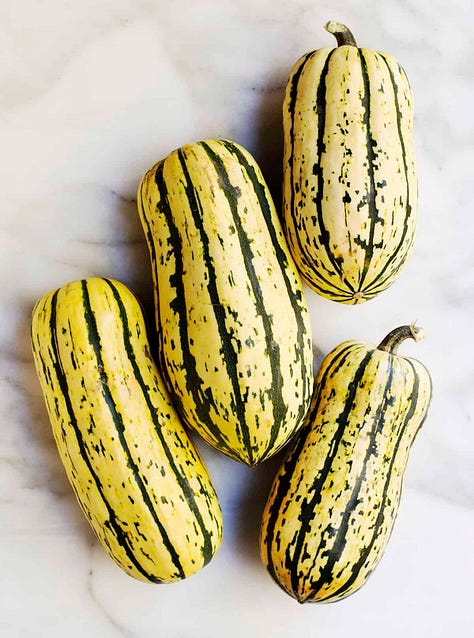
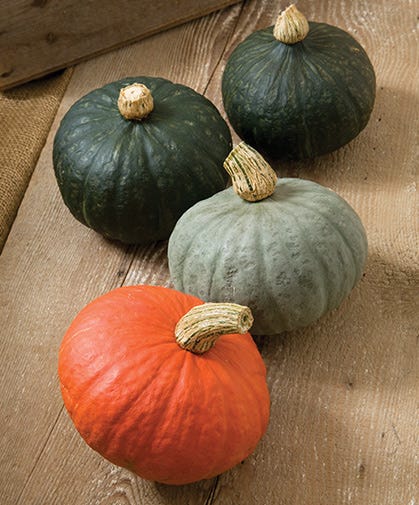
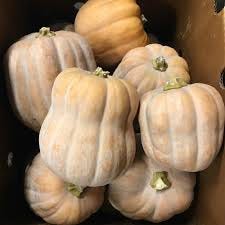
Squash varieties (L to R): Delicata, Kabocha, Koginut Delicata – a funky variety of winter squash with a distinctive cylindrical shape and pale yellow outer skin with dark green stripes. The flesh is light yellow and super sweet, smooth, and moist. The outer skin is very thin, and it doesn’t need to be peeled, which makes delicata super easy to prepare and enjoy.
Kabocha – also known as a Japanese pumpkin, this short and rounded variety of winter squash can have either orange or green outer skin, and bright orange flesh. The flavor is super sweet, dense, and creamy and makes a fabulous soup or puree.
Koginut – a lesser known but increasingly popular type of winter squash, which is a cross between kabocha and butternut squash. Koginuts have a unique squatty shape and a light brown/cream outer skin with vivid orange flesh. The flavor is very sweet and the texture is velvety smooth… definitely give this variety a try if you can find it!


Pie/Sugar Pumpkin – Pie (aka Sugar) pumpkins are specifically bred for cooking/baking (the larger varieties of pumpkins used for Jack ‘O Lanterns are certainly edible, but their watery, fibrous flesh won’t be nearly as delicious). Pie pumpkins tend to be on the smaller side, and are a good all-around winter squash with classic sweet and smooth flesh.
Spaghetti – with it’s unique flesh that’s reminiscent of angel hair pasta when cooked, Spaghetti squash makes a great grain-free pasta option. Spaghetti squash have a distinctive oblong shape and light yellow outer skin. The noodle-like flesh is mild and delicate, and is delicious when tossed in a yummy pasta sauce.
Alright, now that you’ve got the low-down on same of the most common varieties of winter squash, let’s dig into this week’s recipe for Roasted Delicata Squash Stuffed with Moroccan Spiced Quinoa!
I know I shouldn’t play favorites, but if winter squash were my children… then delicata would be my favorite child. What’s not to love? The flesh is suuuper sweet + nutty and cooks quickly, and the outer skin is nice and thin, which means you don’t have to mess with peeling anything.
Today’s recipe makes a gorgeous fall side dish or vegetarian entree, featuring some simply roasted delicata squash that’s been stuffed with a Moroccan-inspired quinoa mixture. The quinoa is filled with warming spices, bright citrus, fresh herbs, and plump pomegranates (or dried cranberries) – and you’ll likely have extra of the Moroccan quinoa situation, which makes a great salad the next day. I love this recipe because it’s easy enough to pull off on a busy weeknight, but it’s also impressive enough to be the star at your next dinner party.
Side note – I know delicata isn’t the most common winter squash, so you may not find it at the grocery store... but most local farmers markets should have it! But if you can’t find delicata, substitute with acorn or kabocha squash.
Keep reading for the full recipe, including a 1-page PDF for easy printing.
A reminder that access to my weekly recipe is only available to paid subscribers (free subscribers get access to the full recipes once a month, on the 1st Friday).
To get in on this deliciousness, consider joining as a paid subscriber! You’ll also get access to my full recipe archive, my gardening resource library, monthly giveaways, and you’ll be able to join our comment and chat sections.
Roasted Delicata Squash Stuffed with Moroccan Spiced Quinoa
Serves 4-6
INGREDIENTS
2 or 3 medium sized delicata squash (or substitute with acorn or kabocha squash)
4 tablespoons olive oil, divided
Kosher salt & pepper
1.5 cups water
1 cup uncooked quinoa
1 yellow onion, diced
2-3 cloves garlic, minced
1 teaspoon ground cumin
1/2 teaspoon paprika
1/2 teaspoon ground coriander
1/4 teaspoon cinnamon
1 bunch lacinato kale, de-stemmed and finely chopped
Juice and zest of 1 lemon
Handful finely chopped fresh parsley (around ¼ cup)
Handful finely chopped mint leaves (around ¼ cup)
½ cup pomegranate seeds OR dried cranberries
4 ounces feta cheese, diced or crumbled (optional)
PREPARATION
Preheat your oven to 400°F.
Cut the delicata squash in half lengthwise and scoop out the seeds. Rub 2 tablespoons of the olive oil on the cut sides of the squash and season to taste with kosher salt and pepper.
Place the squash, cut side down, on a baking sheet and roast for 15 minutes. Flip the squash over and continue cooking, cut side up, until you can very easily pierce the flesh with a knife, about 15 minutes longer (timing will depend on size of the squash). Remove the squash from the oven and set aside.
While the squash roasts, in a medium saucepan bring 1.5 cups of water to a boil. Stir in 1 cup uncooked quinoa and ¼ teaspoon kosher salt, cover tightly with a lid, and reduce the heat to low. Cook at a gentle simmer until the liquid is absorbed, 15 minutes. Turn off the heat and allow the quinoa to steam for 5 minutes, then fluff with a fork and transfer cook quinoa to a large bowl.
While the squash and quinoa are cooking, add 2 tablespoons of olive oil in a wide saute pan/skillet over high heat. When the oil is hot, add 1 diced yellow onion and saute until translucent, 4 to 5 minutes. Reduce heat to medium-low and add 2-3 cloves minced garlic, 1 teaspoon cumin, ½ paprika, ½ teaspoon coriander, and ¼ teaspoon cinnamon to the skillet. Saute until fragrant, about 2 minutes, stirring constantly to keep the aromatics from burning. Add 1 bunch finely chopped kale and juice of 1 lemon, and saute until the kale wilts significantly, 3 to 4 minutes. Remove this mixture from the heat and add to bowl with the cooked quinoa.
Add the chopped parsley and mint, zest from 1 lemon, 1 teaspoon kosher salt, and ½ cup pomegranates (or dried cranberries), and 4 ounces feta cheese (if using) to the bowl of quinoa and toss until combined. Taste and adjust seasoning as needed.
Divide the quinoa mixture to fill the cavities of the roasted squash (you’ll likely have extra quinoa... it makes a great salad the next day)! Garnish with any extra herbs, pomegranates (or cranberries), and feta (if using). Option to pop the stuffed squash into your hot oven for a few minutes to get them nice and toasty again. A reminder that the outer delicata squash skin is edible (and delicious)!
If you’ve found yourself here and haven’t yet subscribed to the Eat Like a Farmer newsletter, join us! Consider signing up for a paid subscription to receive a new straightforward + seasonal recipe *every* week, and get access to comments, chat threads, monthly giveaways, and bonus gardening + cooking resources.








I cannot wait to try this. Delicata and quinoa are both favorites of mine!!